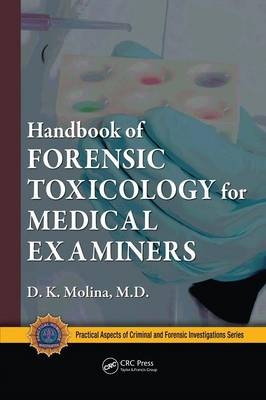
Handbook of Forensic Toxicology for Medical Examiners
Seiten
2009
Crc Press Inc (Verlag)
978-1-4200-7641-7 (ISBN)
Crc Press Inc (Verlag)
978-1-4200-7641-7 (ISBN)
- Titel erscheint in neuer Auflage
- Artikel merken
Zu diesem Artikel existiert eine Nachauflage
Referencing some of the most common toxic drugs and their levels of toxicity, this title describes how to obtain and submit samples, explains methods of analysis, provides hundreds of tables and data sets on substances causing toxicity that are commonly seen in forensic practice, and includes several appendices.
Forensic professionals, often working through heavy caseloads, require quick and easy access to reliable sources of information to help interpret toxicology results. While several in-depth resources are available, they are often large, cumbersome, and contain more information than is needed. The Handbook of Forensic Toxicology for Medical Examiners is a concise handbook referencing the most common toxic substances and their levels of toxicity, making it an ideal text for quick confirmation in the field or in the lab.
The book begins by explaining the proper selection and submission of specimens for toxicological analysis. It describes the various types of specimens and identifies the cases for which these specimens would be most useful, providing instruction on proper collection. The author then explains the methodology involved in performing the specific tests.
Nearly 300 Toxic Substances Discussed
The main section of the text consists of an alphabetical listing of nearly 300 toxic substances, including drugs of abuse, poisons, prescription drugs, and over-the-counter medications. For each entry, the book provides the common brand names; classification; half life; volume of distribution; usual dosage; tables of toxicity in various samples, including blood, urine, and tissues; and other important information based on the extensive experience of the author. The text is heavily referenced with materials that are useful for preparation of courtroom testimony, and it contains supplemental appendices with information on acetylcholinesterase inhibitors, drugs that prolong the QT interval, pharmacogenetics, normal laboratory values, and conversion charts.
Convenient Format
The busy forensic professional needs a concise handbook that provides critical information quickly without the need to wade through extraneous and inconsequential material. This volume offers an easy-to-use format that allows quick access to the most pertinent information, saving time and increasing accuracy.
Forensic professionals, often working through heavy caseloads, require quick and easy access to reliable sources of information to help interpret toxicology results. While several in-depth resources are available, they are often large, cumbersome, and contain more information than is needed. The Handbook of Forensic Toxicology for Medical Examiners is a concise handbook referencing the most common toxic substances and their levels of toxicity, making it an ideal text for quick confirmation in the field or in the lab.
The book begins by explaining the proper selection and submission of specimens for toxicological analysis. It describes the various types of specimens and identifies the cases for which these specimens would be most useful, providing instruction on proper collection. The author then explains the methodology involved in performing the specific tests.
Nearly 300 Toxic Substances Discussed
The main section of the text consists of an alphabetical listing of nearly 300 toxic substances, including drugs of abuse, poisons, prescription drugs, and over-the-counter medications. For each entry, the book provides the common brand names; classification; half life; volume of distribution; usual dosage; tables of toxicity in various samples, including blood, urine, and tissues; and other important information based on the extensive experience of the author. The text is heavily referenced with materials that are useful for preparation of courtroom testimony, and it contains supplemental appendices with information on acetylcholinesterase inhibitors, drugs that prolong the QT interval, pharmacogenetics, normal laboratory values, and conversion charts.
Convenient Format
The busy forensic professional needs a concise handbook that provides critical information quickly without the need to wade through extraneous and inconsequential material. This volume offers an easy-to-use format that allows quick access to the most pertinent information, saving time and increasing accuracy.
Practical Homicide Investigation Inc, New York, USA
Collection and Selection of Toxicologic Specimens
Types of Specimens and Utility
Blood
Urine
Vitreous
Bile
Tissue Specimens
Stomach Contents
Hair
Specimen Collection
Blood
Urine
Bile
Vitreous
Tissue
Hair
Labeling and Storage
Selected Sources
Methodology
Screening Tests
Immunoassay
Spectrophotometry
Chromatography
Confirmatory Tests
Testing Panels
Additional Testing
Selected Sources
Alphabetical Listing of Drugs
Appendices
Index
| Erscheint lt. Verlag | 21.7.2009 |
|---|---|
| Reihe/Serie | Practical Aspects of Criminal and Forensic Investigations |
| Zusatzinfo | 305 Tables, black and white; 1 Illustrations, black and white |
| Verlagsort | Bosa Roca |
| Sprache | englisch |
| Maße | 156 x 235 mm |
| Gewicht | 567 g |
| Themenwelt | Studium ► 2. Studienabschnitt (Klinik) ► Pharmakologie / Toxikologie |
| Studium ► 2. Studienabschnitt (Klinik) ► Rechtsmedizin | |
| ISBN-10 | 1-4200-7641-8 / 1420076418 |
| ISBN-13 | 978-1-4200-7641-7 / 9781420076417 |
| Zustand | Neuware |
| Haben Sie eine Frage zum Produkt? |
Mehr entdecken
aus dem Bereich
aus dem Bereich
Buch | Hardcover (2024)
Thomas Karow (Verlag)
57,80 €
Buch | Hardcover (2022)
Urban & Fischer in Elsevier (Verlag)
99,00 €



